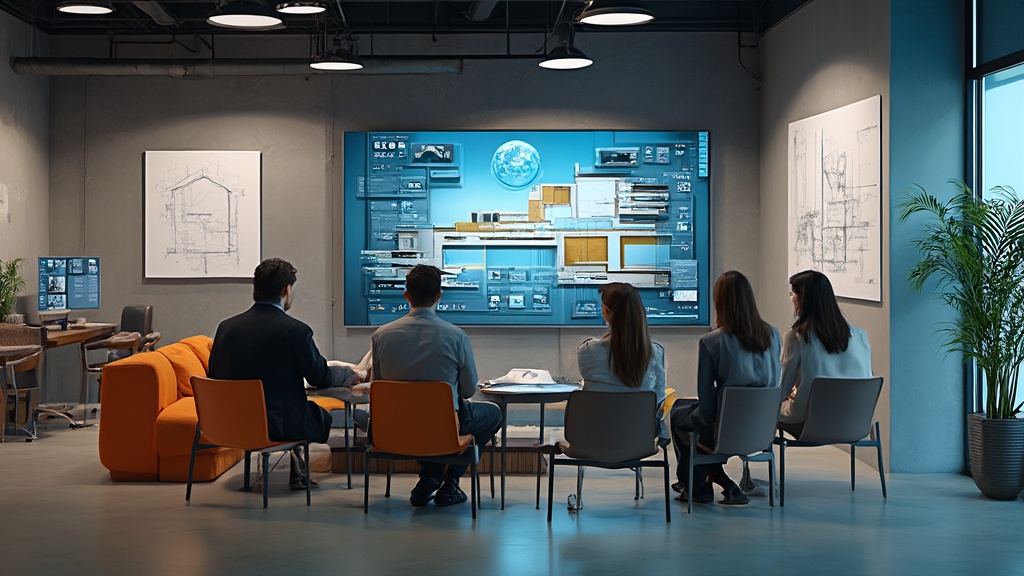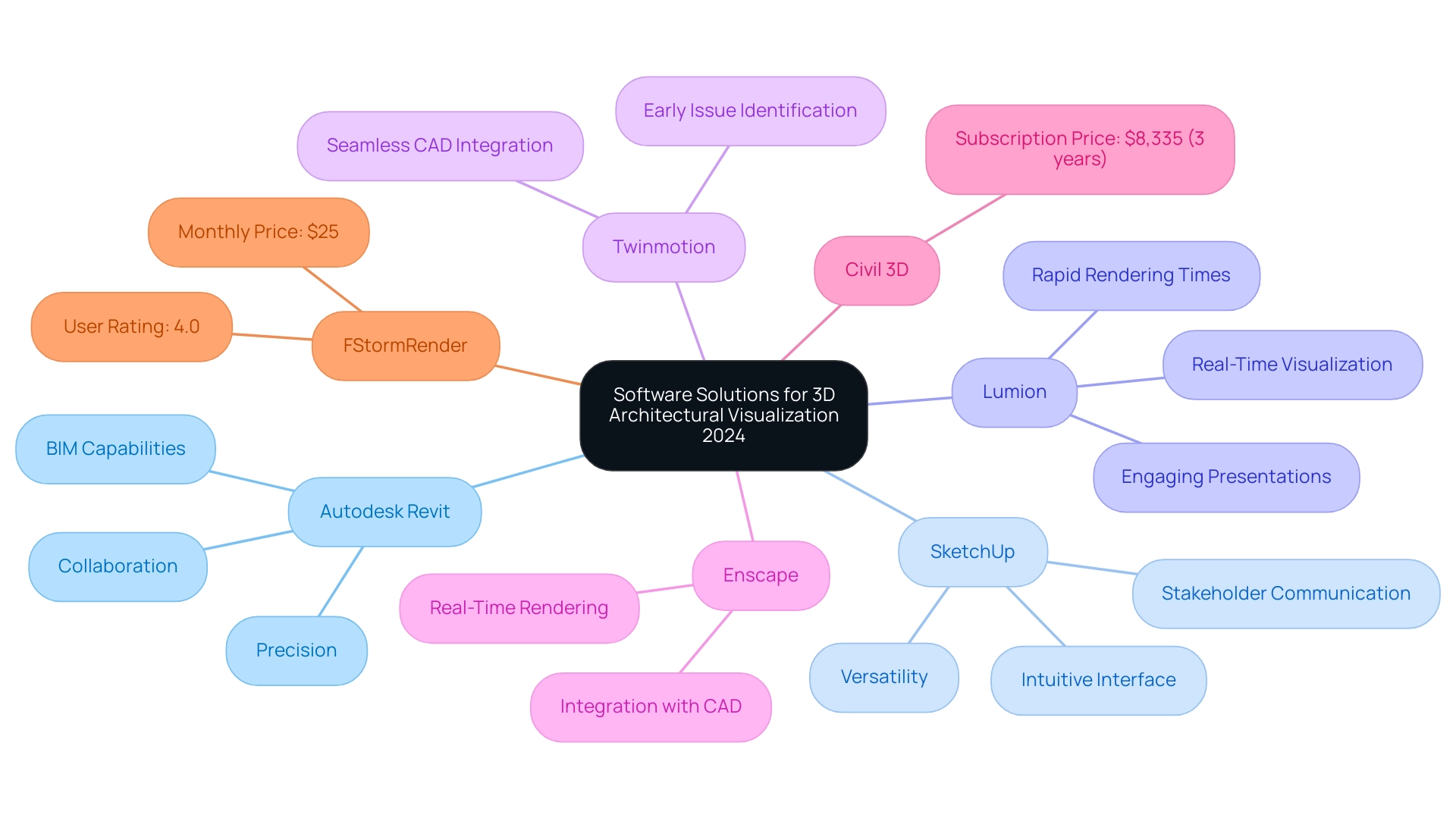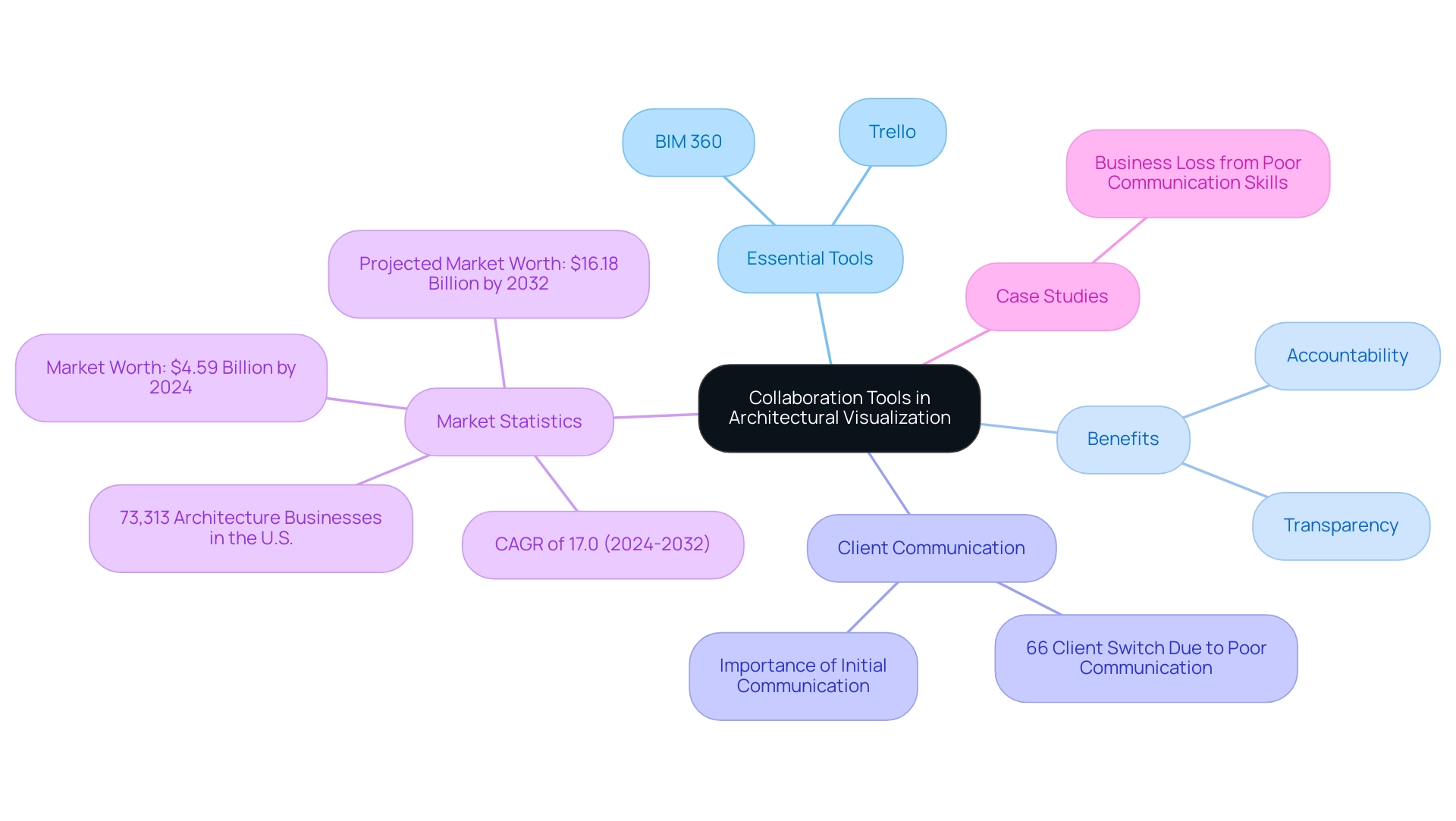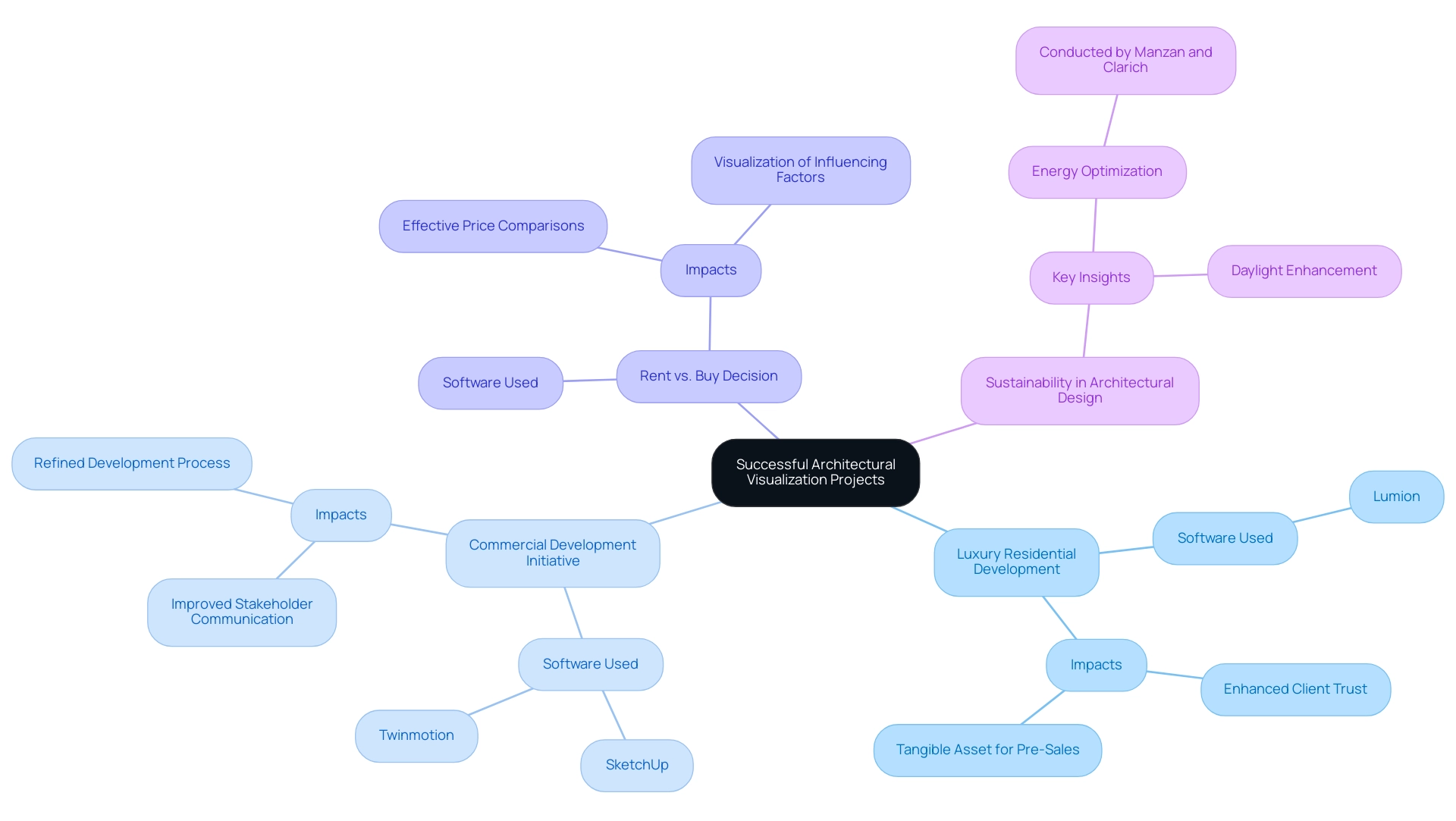Overview:
The trends in the best software for 3D architectural visualization in 2024 highlight the increasing importance of tools like Autodesk Revit, SketchUp, and Lumion, which enhance collaboration, rendering quality, and real-time visualization capabilities. The article underscores that advancements such as AI integration and virtual reality not only streamline the design process but also significantly improve client engagement and satisfaction, demonstrating the critical role these technologies play in modern architectural practices.
Introduction
In 2024, the field of 3D architectural visualization is witnessing a remarkable evolution, driven by the emergence of innovative software solutions and transformative trends. As architects strive to create compelling designs that resonate with clients and stakeholders, tools such as:
- Autodesk Revit
- SketchUp
- Lumion
- Twinmotion
- Enscape
are proving indispensable. These platforms not only enhance the precision and quality of visual presentations but also facilitate seamless collaboration throughout the design process.
Furthermore, the integration of artificial intelligence and real-time rendering technologies is reshaping how architects conceptualize and communicate their visions, enabling immersive experiences that bridge the gap between imagination and reality.
This article delves into the leading software options, emerging trends, and essential features that architects must consider to elevate their visualization capabilities and ensure successful project outcomes in an increasingly competitive landscape.
Leading Software Solutions for 3D Architectural Visualization in 2024
In 2024, numerous software solutions have emerged as leaders reflecting the trends in Best software for 3D architectural visualization. Autodesk Revit continues to be a key player, renowned for its comprehensive Building Information Modeling (BIM) capabilities that enhance collaboration and precision in architectural projects, fostering a stronger connection between architects and future homeowners, who become active participants in the creation of their future homes. SketchUp remains popular among architects for its intuitive interface and versatility, catering to both novice and experienced users, thus promoting better stakeholder communication.
Lumion has gained significant attention for its rapid rendering times and exceptional real-time visualization features, allowing architects to present their concepts engagingly and effectively, which is crucial for building excitement among potential residents. Furthermore, Twinmotion and Enscape are increasingly recognized for their seamless integration with various CAD software, facilitating smooth transitions throughout the creation process and aiding in the early identification of issues. Each of these tools possesses distinct functionalities that address different elements of design—from initial conceptual sketches to intricate detailed presentations—making them indispensable for modern architects who are aware of the trends in Best software for 3D architectural visualization and dedicated to refining their visual storytelling capabilities.
The investment in these advanced tools is critical; for instance, Civil 3D offers a three-year subscription priced at $8,335, which architects should consider when budgeting for software solutions. Additionally, FStormRender, priced at $25/month, has achieved an overall rating of 4.0 in 2024, illustrating its performance and user satisfaction in both professional and amateur settings. As Tim S. observes, utilizing such software offers ‘clarity over hand drafting’ and enables easy adjustments to plans, essential for creating detailed layouts like kitchens or bathrooms.
This insight emphasizes the practical advantages of investing in advanced building representation tools, enhancing communication and supporting iterative planning processes while ensuring that all stakeholders are engaged in the vision of their future homes.
Emerging Trends Shaping the Future of Architectural Visualization
The landscape of architectural representation is undergoing a profound transformation driven by trends in Best software for 3D architectural visualization. Artificial Intelligence (AI) is at the forefront, fundamentally altering how architects explore options and automate routine tasks, thus facilitating greater creative expression. A notable case study exemplifying this trend is Gindi Studio, where the implementation of AI-enhanced tools led to a remarkable 300% increase in preliminary planning output, showcasing the tangible benefits of these technologies.
Pre-sales visualization plays a crucial role in enhancing project confidence; our renderings serve as a bridge between concept and reality, empowering developers to generate interest and investment long before the physical construction begins. Virtual Reality (VR) is also transforming client presentations, enabling immersive walkthroughs of concepts prior to execution, fostering a more engaging and informed decision-making process. Furthermore, the demand for real-time rendering is on the rise, with advanced software such as Unreal Engine and Lumion setting the standard for instant visual feedback.
These innovations streamline the creation process and enhance collaboration among stakeholders, ensuring that the final output aligns with client aspirations. As architects adapt to the trends in Best software for 3D architectural visualization, they must fully exploit these technologies’ capabilities to deliver innovative design solutions. George Guida, co-founder of ArchiTAG, aptly encapsulates this necessity:
I do think that architects still will need to stay at the center of being the driver within that process.
This highlights the importance of architects maintaining their central role amidst the technological advancements. Client satisfaction remains crucial, as seen with HData Systems’ dedication to quality and their open, easy project execution process. Additionally, the role of AI in creating lifelike CG humans is pivotal in overcoming the uncanny valley, allowing for more realistic representations in visualizations of structures.
Gehry’s Walt Disney Concert Hall serves as a significant example of contemporary architecture, showcasing how innovation can lead to landmark creations. The interplay between technological advancements, detailed interior renderings, and human intent will undoubtedly influence the future of design in buildings.
The Importance of Collaboration Tools in Architectural Visualization
In the present design environment, effective teamwork serves as a cornerstone of success. Tools such as BIM 360 and Trello are essential for facilitating real-time communication and comprehensive management, enabling teams to share updates, track progress, and manage tasks with precision. These platforms not only optimize workflows but also cultivate a culture of transparency and accountability among team members.
The incorporation of collaboration tools into the visualization process is essential; it greatly minimizes misunderstandings and guarantees that all participants are aligned with the project’s vision, showcasing the trends in Best software for 3D architectural visualization that improve communication and address issues early. This alignment is particularly important in light of the fact that 66% of clients have reported switching to competitors due to poor communication skills, as highlighted in the case study titled ‘Business Loss from Poor Communication Skills,’ which illustrates the direct impact of communication on client retention and business success. As the design sector continues to evolve, with over 73,313 architecture businesses in the U.S. and a projected market worth of $4.59 billion by 2024, the market is expected to reach $16.18 billion by 2032, exhibiting a CAGR of 17.0% during the forecast period (2024-2032), according to Fortune Business Insights.
This underscores the importance of adopting advanced collaboration tools for enhancing design outcomes and achieving high levels of client satisfaction. Moreover, with 62% of respondents employing event-driven architecture patterns, the effectiveness of these collaboration tools in architectural visualization and management becomes even more apparent. At J. Scott Smith Visual Designs, we are dedicated to a collaborative rendering process that starts with initial communication and a detailed brief to understand your goals and specific rendering needs.
By ensuring prompt communication through a single point of contact, we engage clients effectively and capture their visions accurately through detailed 3D models. This method not only streamlines the creation process but also significantly reduces expensive alterations later on. Our clients have conveyed their satisfaction, with one stating, ‘Scott’s attention to detail and ability to visualize our ideas turned our endeavor into a reality.’
Ultimately, our cooperative process results in high-quality visualizations that align with our clients’ vision and surpass their expectations.
Key Features to Look for in Architectural Visualization Software
When selecting software for architectural visualization, it is essential to prioritize several key features that can greatly influence project success. Rendering Quality stands at the forefront; exceptional renderings, especially those that incorporate meticulous detail and precision, can dramatically enhance client presentations, making them a critical aspect of effective communication in architecture. AEC leaders should consider implementing a digital asset management (DAM) system for enhanced accessibility and organization among all contributors within AEC marketing, as high-quality visuals are essential in conveying intent.
Furthermore, Ease of Use is crucial; intuitive interfaces can significantly reduce the learning curve and boost productivity among team members. Integration Capabilities with essential creation tools, such as CAD software, ensure a smooth workflow, facilitating the seamless exchange of information. In today’s fast-paced environment, Support for Real-time Rendering is also vital, as it allows architects to make instantaneous adjustments during client meetings, enhancing responsiveness and engagement.
Additionally, Collaboration Features are increasingly important, with 62% of architecture firms utilizing cloud-based collaboration tools for project coordination. This statistic underscores the need for software that promotes effective teamwork and communication. The case study titled ‘Navigating Unclear Role Definitions’ illustrates this point, as unclear roles within a team can lead to conflicts; thus, having clear collaboration features in software can mitigate such issues.
Furthermore, the advantages of initial conceptual renderings—such as rapid representation, cost-efficiency, informed decision-making, improved communication, and assistance for an iterative development process—should also influence software choice, as they simplify the creative process and enhance stakeholder interactions. The iterative nature of these renderings permits ongoing feedback and refinement, which is essential in attaining the desired outcome. Ultimately, the trends in Best software for 3D architectural visualization are dominating the 3D rendering industry in 2023, making it essential to choose the appropriate tools for building representation.
By focusing on these core features, architects can choose software that not only fulfills their immediate requirements but also evolves to meet future industry challenges, ensuring precision and detail in every aspect of their designs.
Case Studies of Successful Architectural Visualization Projects
Numerous case studies emphasize the effective use of 3D architectural representation in various initiatives, underscoring the pivotal role it plays in enhancing confidence and generating investment. A notable instance is a recent luxury residential development where Lumion was employed to produce striking visualizations, which served as a tangible asset in pre-sales efforts. This not only aided in securing client approval during the development phase but also sparked interest and investment long before the physical realization of the project.
The software’s real-time rendering capabilities enabled the client to virtually experience the space, fostering immediate feedback and timely adjustments to the layout, which is crucial for maintaining trust and reliability in client partnerships. One client remarked, ‘The representations brought our vision to life and made it easy to communicate our ideas to stakeholders.’ Additionally, a commercial development initiative showcased the synergy between SketchUp and Twinmotion; initial concepts created in SketchUp were later refined with detailed representations in Twinmotion.
This dual-software approach not only refined the development process but also enhanced stakeholder presentations, ultimately contributing to a successful project launch. Additionally, the case study titled ‘Is it Better to Rent or Buy?’ demonstrates how graphical representation assists in decision-making, enabling homeowners to compare prices efficiently through comprehensive visuals.
As mentioned by Peng, C., in ‘A Review of Performance-Oriented Architectural Design and Optimization in the Context of Sustainability,’ the significance of graphical representation extends beyond aesthetics, emphasizing its role in sustainable design practices. Furthermore, rapid energy and daylight enhancement carried out by Manzan and Clarich further emphasizes the advantages of employing 3D representation tools in building projects. These instances exemplify the critical importance of selecting the appropriate software and embracing cutting-edge trends to achieve superior outcomes in architectural visualization, ultimately enhancing client satisfaction and marketing effectiveness.
Conclusion
The evolution of 3D architectural visualization is transforming how architects engage with clients and streamline their design processes. Key software solutions such as:
- Autodesk Revit
- SketchUp
- Lumion
- Twinmotion
- Enscape
enhance workflow efficiency and produce compelling visual presentations that resonate with stakeholders. The integration of artificial intelligence and real-time rendering technologies further enriches the design experience, enabling more effective communication of architectural visions.
Emerging trends like virtual reality and pre-sales visualization are reshaping client interactions, providing immersive experiences that facilitate informed decision-making. Effective collaboration is essential for project success, with tools like:
- BIM 360
- Trello
enhancing real-time communication and ensuring alignment among all stakeholders. The role of advanced collaboration tools in minimizing misunderstandings is vital for maintaining client relationships.
Choosing the appropriate architectural visualization software is critical. Architects must prioritize features such as:
- Rendering quality
- User-friendliness
- Integration capabilities
- Real-time rendering support
These features not only enhance the design process but also foster transparency and accountability within teams, as demonstrated by case studies showcasing the positive impact of effective visualization on client satisfaction and investment.
In conclusion, the future of architectural visualization is bright, driven by technological advancements and a focus on collaboration. By embracing these innovative tools and practices, architects can enhance their visual storytelling capabilities, ensuring that their designs not only meet but exceed client expectations in a competitive landscape.






0 Comments